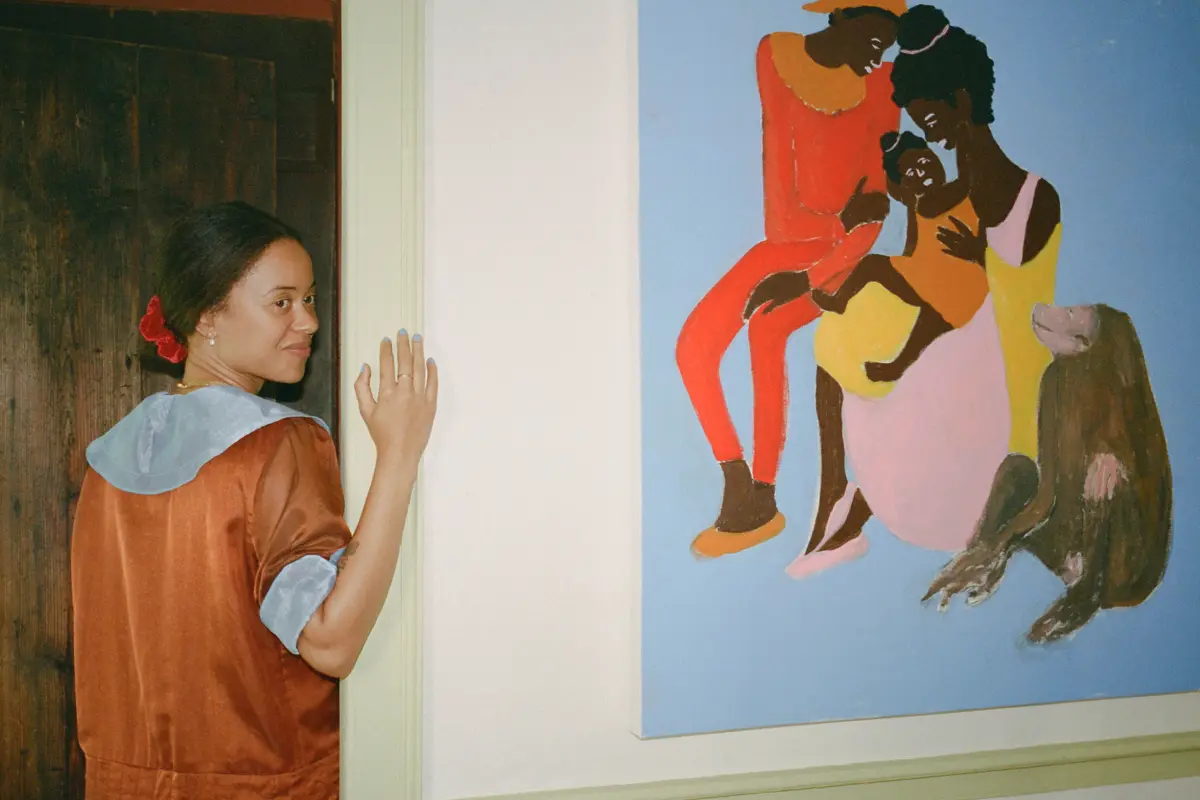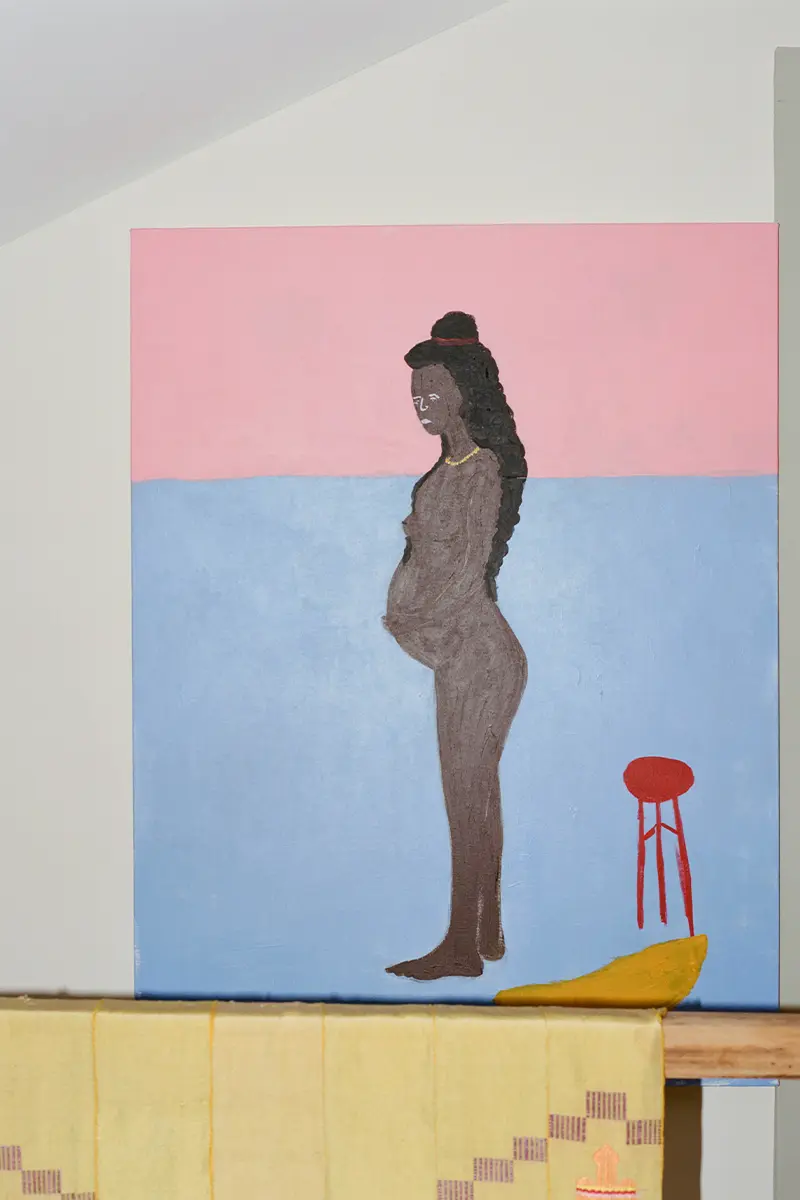«Galleries should have no expectations. Every artist has overworked or underworked something. I will be the only one to know if it’s finished». Cassi Namoda on her approach to work and art
Magical House – the art studio and home
«I ended up in this random town in the Berkshires, and I don’t know how I got attracted. But I am in this house that feels mine intuitively. This house was built in the 1850s by Amasa Spencer, whose son died from influenza and was buried in the back».
Namoda found his tombstone inside the vernacular-style barn, with other parts scattered outside and covered in thick moss fur. That led her to look under the house where that magical plot had a complex system of wild strawberries, blueberries, raspberries, and various flowers. Simultaneously, this love of the house guided her to work on Picasso rose period-inspired paintings, ingrained in her family memories, the times they traveled around similar to a circus family.
Namoda claims to be a traveling artist, but at the same time, she’s rooting herself with a house in Berkshires, her dog Bernadette and other things which help her stay connected to the specific place. She has her live/work studio in East Hampton, as a retreat and workplace. «It’s 2000 square feet – utilitarian and practical; I have a painting storage there. But in the same way, it is amidst nature».
«I was inspired by a friend who bought 250 acres, an old house in Massachusetts. I’ve spent two months getting to know the dark there because it’s different. I fell in love with this region. There’s something maternal and interior about being in the mountains. I’ve moved around in many different landscapes, which made me feel sensitive to needing it all. And I believe that we can have it all if we manifest that for ourselves».
Historically, Berkshires was a home for many painters, writers, dancers, and critical cultural thinkers. It’s a communal place with activities like collective ‘plein air’ painting every Thursday.
«The house was timely, the region called me, and I knew there’s something to learn. Do I know if I’ll be here forever? I don’t. I think that I could see it, but America’s also a complicated place».
Cassi Namoda’s Creative Process
«I want to connect with what’s in front of me. The beauty becomes literal. When I’m in my studio in Long Island, I’m less than a painter, but more a researcher or storyteller. There is something functional about white walls. You also can’t be too comfortable, and I always like my studio a little cold».
Namoda went for a residence in West Cork, Ireland, at the Albers Residency program to take on plain air painting in hopes of differentiating her practice in New England. «I’m working on watercolors, but I can’t transport my mind to a certain place that inspires me. I look out at those mountains and want to stare at that color. I’m obsessed with lines and loose shapes. My mind is fluid at the moment that it almost reminds the landscape».
«I feel pregnant with work. All these ideas want to have a birth. I see this as a rich time».
In the little UWS apartment, Namoda is working on a series of reimagined religious paintings, which she’s trying to adopt in a personal, more intimate way. Previously, she reworked Picasso’s rose period in watercolor in Long Island’s place which is intended for large-scale works.
«I’ve made it clear to the galleries that they should have no expectations. I’ve been rather abundant in how I have painted, but I don’t have the pressure to release new ones. Something exceptional happens when you don’t work on deadlines. Every artist has overworked or underworked something. I will be the only one to know if it’s finished. No one needs to visit your studio or know what you are working on until you tell them that you have something for them».
Building an artist’s lifestyle takes a certain amount of strength, organization, and awareness. Namoda had to sell her early work to sustain a living and then find suitable galleries to have stability. «If you’re lucky, don’t give early work away. Those are relevant because they do something in the midst».
The self-care routine, the cycle and the nature grounding
«Sometimes I need to fall off and re-meet myself. It’s a cycle. Having hygiene is in terms of sleeping and nature grounding. I always meet myself at the end of the day and say, «there’s never enough hours in a day».
Namoda states she doesn’t even know how to be a good boss, but takes it as a learning process.
Starting the morning with lemon water, exercising to build strong muscles, eating healthily, and keeping good friends around are the basic things in Namoda’s routine. There are a few local friends with whom Namoda is connected in Massachusetts. Josephine Halverson, her plein air painter friend, and Josie, photographer and artist. «We live individual lives, but when we get together, it’s so enriching to talk about culture, theory, and history. People are more real here. On the other hand, in the Hamptons, it’s all about what you are doing and which gallery you are repped by».
Painting in the studio in East Hampton
Namoda has her alarm clock set at 8:05 am, with an extra minute added on purpose. Then she walks her dog Bernadette, which brings consistency to daily life. After the walk, Namoda plays BBC World News and writes notes while waiting for a coffee. The rest of the schedule varies depending on where she is, whether New York City, Berkshires, or East Hampton. Since Cassi Namoda was in Berkshires during this interview, her day has to start with a large cup of coffee. She claims, «things are relaxed here, so I need to be caffeinated».
Before 2 pm, Namoda usually walks to the Rare Books shop, browsing through Henri Rousseau or William Eggleston books. In the summertime, she goes swimming in Stockbridge Beach, picks ups or makes something for lunch, and heads upstairs to paint small-scale works. «I can’t paint during the day. There are too many distractions. I’m a nighttime painter. I paint with soft amber light».
Namoda prefers to paint in her studio in East Hampton. Therefore in Berkshires, she sets up a fire in the evening and watches cable tv. By 9 pm, she would be in bed with a book. «Most of the time, the process is staring at empty canvases. Every day you’re working, whether physically in movement or sitting, something’s happening».
Cassi Namoda – Behind the painting
Different characters appear depending on the body of the painting Namoda is working on. Something in religious sentiment would mean a family similarity to her. The character Maria relates to the middle family name from her mother’s side and the history behind that. Her uncle’s character also participated in one of the recent works shown during Freeze in London.
«I’m interested in creating new worlds. reveal them to tell a fascinating and intriguing story». Those places are usually urban environments, slow culture worlds.
Mythology is also one of them, along with Flemish primitive depictions. «I’m learning how to tell a good story and have a desire in some respect to be a venture».
Cape Town Art Fair in February and a show in London
Namoda shared a busy schedule which includes an exhibition in London in November 2023. Joseph’s residency in Senegal this winter, followed by Cape Town Art Fair in February. She plans to spend her spring in New Haven, CT, residence.
Long before that, Namoda had her first show in her house in LA. There were paintings of the family’s village in watercolor. Then her friend asked to do a show in her living room, where many more people showed up, and the word-of-mouth game began. It was the right place and time. «I always tell other artists it’s not about showing at a gallery. It’s sometimes about doing it in your friend’s place and making sure you do something authentic and individualistic to you».
Nina Johnson offered Namoda the first gallery contract in early 2019, which helped to make that ‘breakthrough’.
Cassi Namoda. Purpose of creation
«I can’t speak for others, but it’s a personal need. I would’ve gone crazy if I didn’t create».
Only some people are familiar with primarily toxic painting materials. «At times, I’ve tended to lean to some autoimmune diseases, working with specific pigments. I see how my body is starting to change». Namoda admits that she would prefer to create her natural pigments and produce paper, but it could happen only in a place where those items aren’t accessible, so she would need to think about her way of creating them.
The sympathy with Eckhaus Latta
Namoda’s style is primarily utilitarian, which correlates with her lifestyle. As her daily uniform, she prefers overalls with boots. This is because she’s in the phase of life when it’s mainly working rather than partying. However, Paris is an exception to having fun and being fancy-free in Namoda’s decorative way of dressing. Namoda designs her dresser with a tailor in the Hamptons and Africa.
«I’m not interested in fashion, but I have friends that I support. Eckhaus Latta is one of the best labels that I can relate to. It’s always inspiring and fresh. It’s amusing to me, regardless of whether I wear it or not».
Cassi Namoda’s art circle
«I don’t care about fitting in. No one has the way I grew up or the same story. Sometimes I’ve felt like a black sheep, and it’s been hard to relate, but then you have to make yourself relatable. That’s a part of socialization». Despite that, Namoda maintained a genuine connection with creative individuals based on sincere interest.
Although Namoda decided to spend the majority of her time out of that circle. «I don’t know what it would be to constantly work in our environment and go into your thoughts to make something. It’s so much work».
Namoda isn’t interested in becoming a famous public figure, and she finds herself happy creating work and planning on moving to an island in East Africa to reconnect with her roots. She’s not about competition and the ego-centric modern artist’s world. Instead, her preference would be a sit with masters in the Louvre. «They have a place, and I appreciate them, but I live a quiet life».
Cassi Namoda
Cassi Namoda was born in Mozambique. Her parents separated at a young age, and due to the father’s work in a non-profit, they repositioned every four years. He focused on children’s education, women’s rights, and anything a particular region needed. Namoda now lives in the US.




















